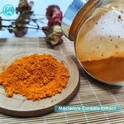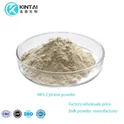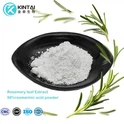What is Dihydromyricetin ?
Dihydromyricetin is a potent dihydropyrimidase inhibitor with IC50 of 48 μM. Dihydromyricetin activates autophagy by inhibiting mTOR signaling. Dihydromyricetin inhibits mTOR complex (mTORC1/2) formation.
Bioactivity
Target:Dihydropyrimidinase: 48 μM (IC50);mTORC1;mTORC2;Autophagy
In vitro studies: Dihydromyricetin, a flavonol, significantly inhibits the catalytic activity of dihydropyrimidase towards the natural substrate dihydrouracil and the xenobiotic substrate 5-propyl-hydantoin. Dihydromyricetin showed a significant inhibitory effect on the activity of dihydropyrimidase on both substrates, even more so than myricetin. The IC50 values of dihydromyricetin for dihydropyrimidase determined using titration curves of dihydrouracil and 5-propylhydantoin were 48±2 and 40±2 μM, respectively[1]. Dihydromyricetin (DHM) supplementation significantly reversed the increase in mTOR phosphorylation at Ser2448 (p-mTOR) during D-gal administration, suggesting that dihydromyricetin can activate autophagy by inhibiting mTOR signaling.
natural substrate dihydrouracil and the xenobiotic substrate 5-propyl-hydantoin. Dihydromyricetin showed a significant inhibitory effect on the activity of dihydropyrimidase on both substrates, even more so than myricetin. The IC50 values of dihydromyricetin for dihydropyrimidase determined using titration curves of dihydrouracil and 5-propylhydantoin were 48±2 and 40±2 μM, respectively[1]. Dihydromyricetin (DHM) supplementation significantly reversed the increase in mTOR phosphorylation at Ser2448 (p-mTOR) during D-gal administration, suggesting that dihydromyricetin can activate autophagy by inhibiting mTOR signaling.
In vivo study :The normal control group, D-gal group, D-gal + dihydromyricetin (100 mg/kg) group, D-gal + dihydromyricetin (200 mg/kg) group were assessed by Morris water maze (MWM) Changes in the ability of learning and memory in rats) (n = 10 per group). Dihydromyricetin (DHM) treatment significantly shortens escape latency compared with D-gal-induced model group.
Solubility:In vitro:DMSO: ≥100 mg/mL (312.26 mM),"≥" means soluble, but the saturation is unknown.In vivo: 1. Add each solvent one by one: 10% DMSO 90% (20% SBE-β-CD in saline) Solubility: ≥ 2.5 mg/mL (7.81 mM); clear solution 2. Add each solvent one by one: 10% DMSO 40% PEG300 5% Tween-80 45% Saline Solubility: ≥ 2.5 mg/mL (7.81 mM); Clear Solution 3. Add each solvent one by one: 10% DMSO 90% Corn Oil Solubility: ≥ 2.5 mg/mL (7.81 mM); clear solution.
Stock solution:
1 mM 3.1226 mL 15.6128 mL 31.2256 mL
5 mM 0.6245 mL 3.1226 mL 6.2451 mL
10 mM 0.3123 mL 1.5613 mL 3.1226 mL
Kinase assay :Rapid spectrophotometric assays are used to determine the enzymatic activities of hydantoinase, allantoinase, dihydrotyrosinase and iminase. Dihydrouracil, 5-propyl-hydantoin and phthalimide were used as substrates. Unless explicitly stated otherwise, dihydrouracil (2 mM) was used as the substrate in the standard assay for dihydropyrimidase. Briefly, the decrease in absorbance at 230, 248 and 298 nm was measured upon hydrolysis of dihydrouracil, 5-propyl-hydantoin and phthalimide as substrates at 25 °C, respectively. To start the reaction, purified dihydropyrimidase (10-70 μg) was added to 2 mL of a solution containing substrate and 100 mM Tris-HCl (pH 8.0). Substrate hydrolysis was monitored with a UV/vis spectrophotometer. The extinction coefficient of each substrate was experimentally determined by direct measurement with a spectrophotometer. The extinction coefficients of dihydrouracil, 5-propyl-hydantoin and phthalimide are 0.683 mM-1 cm-1 at 230 nm, 0.0538 mM-1 cm-1 at 248 nm, and 0.0538 mM-1 cm-1 at 298 nm, respectively at 3.12mM-1cm-1. The initial rate of change was a function of the enzyme concentration in the absorbance range of 0.01-0.18 min-1.The unit of activity is defined as the amount of enzyme that catalyzes the hydrolysis of 1 μmol of substrate per minute, and the specific activity is expressed in units of activity per mg of enzyme. Kinetic parameters Km and Vmax were determined from nonlinear plots by fitting the hydrolysis rates from the individual experiments to the Michaelis-Menten equation .
Cellular experiments: Hippocampal and cortical tissue samples were lysed in lysis buffer containing 20 mM Tris (pH 7.5), 135 mM NaCl, 2 mM EDTA, 2 mM DTT, 25 mM β-glycerophosphate, 2 mM sodium pyrophosphate, 10% glycerol, 1% Triton X Homogenize. -100, 1 mM sodium orthovanadate, 10 mM NaF, 10 μg/mL aprotinin, 10 μg/mL leupeptin and 1 mM PMSF on ice for 30 min and centrifuged at 12000 x g, 4 °C for 30 min. The supernatant was collected and protein quantification was performed using the BCA kit. The protein samples were boiled for 5 minutes at 95°C in the presence of sample buffer. Target proteins were separated by sodium dodecyl sulfate polyacrylamide gel electrophoresis (SDS-PAGE), transferred to nitrocellulose membranes, and probed with corresponding primary and secondary antibodies. Finally, visualize the target protein by exposure to X-ray film by enhanced chemiluminescence (ECL) reagents.
Animal experiments: Rats 40 male Sprague-Dawley (SD) rats (age: 8 weeks old; body weight: 160±20 g) were used. Rats were randomly divided into 4 groups, including normal control group, D-gal model group and D-gal combined with DHM, with doses of 100 and 200 mg/kg-d, respectively, with 10 rats in each group. All rats were housed in an environment with room temperature of 22 ± 2 °C and a dark photoperiod (12 hr:12 hr) with access to food and water ad libitum. After 1 week of acclimation to the new environment, the rats from the DHM group were administered by gavage with the indicated doses of DHM dissolved in distilled water once a day at 8:00 am for 6 consecutive weeks. Rats from the normal control group were dosed with distilled water. Except for the normal control group, rats in other groups were subcutaneously injected with D-gal at a dose of 150 mg/kg.d for 6 consecutive weeks. Each administration of DHM should be 2 hours before D-gal injection.
Shipping :room temperature; may vary
Physical and chemical properties
Density | 1.8±0.1 g/cm3 |
Boiling point | 780.7±60.0 °C at 760 mmHg |
Melting point | 248 °C |
Molecular formula | C15H12O8 |
Molecular weight | 320.251 |
Flash point | 296.7±26.4 °C |
Reasonable quality | 320.053223 |
PSA | 147.68000 |
Appearance | white to beige |
Vapor Pressure | 0.0±2.8 mmHg at 25°C |
Refractive index | 1.798 |
Storage conditions | 20°C |
Soluble | DMSO: ≥5mg/mL (heated) |
Specification
98%
Our advantages
1.Fast delivery.Quality assuarnce
2.Our R&D team is composed of post-doctoral, biological and food graduates with independent,R&D capabilities.
3.Provide customized packing service.OEM service including :softgel ,capsule, tablet,sachet, granule,etc. Service to produce customer-specific products with more than 100 cusomers worldwide.
4.Over 10 years experience in herballngrents production under GMPstandard. Full experience on herbal extracts quality control and application.







